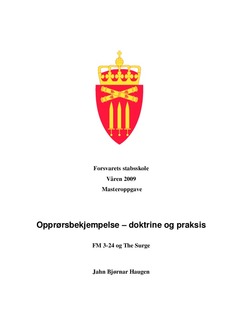| dc.description.abstract | In the new wars of today, the principle of adaption to changing situations is put to the test. The enemy of the state is no longer regular forces and mass armies of other states, but dangerous individuals and armed insurgent groups, operating against a state. The enemies are operating without making the effort to distinguish themselves from the civilian population in order to overthrow the legitimate Government. The US issued a new counterinsurgency doctrine in December 2006 to deal with the growing problems in countering insurgent movements in Iraq and Afghanistan. The next counterinsurgency doctrine emphasizes the need to establish and maintain the security of the population. In January 2007 President Bush changed the mission of US forces to securing the population of Baghdad from sectarian violence. This paper examines to what extent the US operations in Iraq during the Surge are corresponding with the new counterinsurgency doctrine, FM 3-24. Similarities and differences were determined by examining counterinsurgency approaches and logical lines of operations in counterinsurgency against the US operations executed. The operations executed are mostly in line with the counterinsurgency doctrine. However, the shortfall in US and Iraqi security forces advocated, the establishment of concerned local citizens, and the neglect to guard the borders, may inflict on the long-term security situation for the Iraqi people. | en_US |
